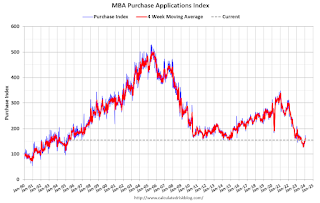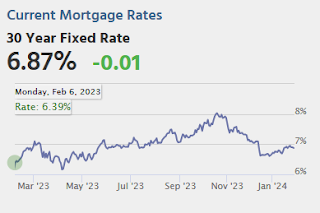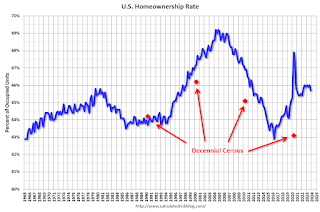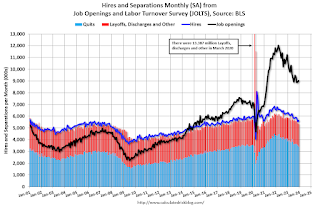by Calculated Risk on 1/31/2024 08:45:00 PM
Wednesday, January 31, 2024
Thursday: Unemployment Claims, ISM Mfg, Construction Spending

Thursday:
• At 8:30 AM ET, The initial weekly unemployment claims report will be released. The consensus is for 210 thousand initial claims, down from 214 thousand last week.
• At 10:00 AM, Construction Spending for December. The consensus is for a 0.5% increase in construction spending.
• Also at 10:00 AM, ISM Manufacturing Index for January. The consensus is for the ISM to be at 47.3, down from 47.4 in December.
Freddie Mac House Price Index Increased in December; Up 6.6% Year-over-year
by Calculated Risk on 1/31/2024 05:07:00 PM
Today, in the Calculated Risk Real Estate Newsletter: Freddie Mac House Price Index Increased in December; Up 6.6% Year-over-year
A brief excerpt:
On a year-over-year basis, the National FMHPI was up 6.6% in December, from up 6.1% YoY in November. The YoY increase peaked at 19.1% in July 2021, and for this cycle, bottomed at up 0.9% YoY in April 2023. ...
As of December, 10 states were below their previous peaks, Seasonally Adjusted. The largest seasonally adjusted declines from the recent peak were in Maine (-3.4%), Idaho (-2.3%), Louisiana (-1.9%), and Washington (-1.8%).
For cities (Core-based Statistical Areas, CBSA), here are the 30 cities with the largest declines from the peak, seasonally adjusted. Austin continues to be the worst performing city.
FOMC Statement: No Change to Policy
by Calculated Risk on 1/31/2024 02:00:00 PM
Fed Chair Powell press conference video here or on YouTube here, starting at 2:30 PM ET.
FOMC Statement:
Recent indicators suggest that economic activity has been expanding at a solid pace. Job gains have moderated since early last year but remain strong, and the unemployment rate has remained low. Inflation has eased over the past year but remains elevated.
The Committee seeks to achieve maximum employment and inflation at the rate of 2 percent over the longer run. The Committee judges that the risks to achieving its employment and inflation goals are moving into better balance. The economic outlook is uncertain, and the Committee remains highly attentive to inflation risks.
In support of its goals, the Committee decided to maintain the target range for the federal funds rate at 5-1/4 to 5-1/2 percent. In considering any adjustments to the target range for the federal funds rate, the Committee will carefully assess incoming data, the evolving outlook, and the balance of risks. The Committee does not expect it will be appropriate to reduce the target range until it has gained greater confidence that inflation is moving sustainably toward 2 percent. In addition, the Committee will continue reducing its holdings of Treasury securities and agency debt and agency mortgage-backed securities, as described in its previously announced plans. The Committee is strongly committed to returning inflation to its 2 percent objective.
In assessing the appropriate stance of monetary policy, the Committee will continue to monitor the implications of incoming information for the economic outlook. The Committee would be prepared to adjust the stance of monetary policy as appropriate if risks emerge that could impede the attainment of the Committee's goals. The Committee's assessments will take into account a wide range of information, including readings on labor market conditions, inflation pressures and inflation expectations, and financial and international developments.
Voting for the monetary policy action were Jerome H. Powell, Chair; John C. Williams, Vice Chair; Thomas I. Barkin; Michael S. Barr; Raphael W. Bostic; Michelle W. Bowman; Lisa D. Cook; Mary C. Daly; Philip N. Jefferson; Adriana D. Kugler; Loretta J. Mester; and Christopher J. Waller.
emphasis added
ADP: Private Employment Increased 107,000 in January
by Calculated Risk on 1/31/2024 08:30:00 AM
Private sector employment increased by 107,000 jobs in January and annual pay was up 5.2 percent year-over-year, according to the January ADP® National Employment ReportTM produced by the ADP Research Institute® in collaboration with the Stanford Digital Economy Lab (“Stanford Lab”). The ADP National Employment Report is an independent measure and high-frequency view of the private-sector labor market based on actual, anonymized payroll data of more than 25 million U.S. employees.This was below the consensus forecast of 130,000. The BLS report will be released Friday, and the consensus is for 162 thousand non-farm payroll jobs added in January.
...
“Progress on inflation has brightened the economic picture despite a slowdown in hiring and pay,” said Nela Richardson, chief economist, ADP. “Wages adjusted for inflation have improved over the past six months, and the economy looks like it's headed toward a soft landing in the U.S. and globally.”
emphasis added
MBA: Mortgage Applications Decreased in Weekly Survey
by Calculated Risk on 1/31/2024 07:00:00 AM
From the MBA: Mortgage Applications Decrease in Latest MBA Weekly Survey
Mortgage applications decreased 7.2 percent from one week earlier, according to data from the Mortgage Bankers Association’s (MBA) Weekly Mortgage Applications Survey for the week ending January 26, 2024. Last week’s results included an adjustment to account for the MLK holiday.
The Market Composite Index, a measure of mortgage loan application volume, decreased 7.2 percent on a seasonally adjusted basis from one week earlier. On an unadjusted basis, the Index increased 8 percent compared with the previous week. The Refinance Index increased 2 percent from the previous week and was 3 percent higher than the same week one year ago. The seasonally adjusted Purchase Index decreased 11 percent from one week earlier. The unadjusted Purchase Index increased 6 percent compared with the previous week and was 20 percent lower than the same week one year ago.
“Mortgage rates changed little last week, with the 30-year fixed rate at 6.78 percent, which is close to where it has been for the past month, but lower than the recent peak of 7.9 percent in October 2023,” said Joel Kan, MBA’s Vice President and Deputy Chief Economist. “Applications decreased compared to a holiday-adjusted week, driven by a decline in purchase applications that offset a slight increase in refinance activity. Low existing housing supply is limiting options for prospective buyers and is keeping home-price growth elevated, resulting in a one-two punch that continues to constrain home purchase activity. The average loan size for purchase applications has picked up in recent weeks to $444,100, the largest average loan size since May 2022.”
...
The average contract interest rate for 30-year fixed-rate mortgages with conforming loan balances ($726,200 or less) remained unchanged at 6.78 percent, with points increasing to 0.65 from 0.63 (including the origination fee) for 80 percent loan-to-value ratio (LTV) loans.
emphasis added
 Click on graph for larger image.
Click on graph for larger image.The first graph shows the MBA mortgage purchase index.
According to the MBA, purchase activity is down 20% year-over-year unadjusted.

Tuesday, January 30, 2024
Wednesday: FOMC Statement, ADP Employment, Chicago PMI
by Calculated Risk on 1/30/2024 08:12:00 PM

Wednesday:
• At 7:00 AM ET, The Mortgage Bankers Association (MBA) will release the results for the mortgage purchase applications index.
• At 8:15 AM, The ADP Employment Report for January. This report is for private payrolls only (no government). The consensus is for 130,000 payroll jobs added in January, down from 164,000 added in December.
• At 9:45 AM: Chicago Purchasing Managers Index for January. The consensus is for a reading of 48.0, up from 46.9 in December.
• At 2:00 PM: FOMC Meeting Announcement. No change to policy is expected.
• At 2:30 PM: Fed Chair Jerome Powell holds a press briefing following the FOMC announcement.
Fannie and Freddie: Single Family Serious Delinquency Rate Increased Slightly, Multi-family Unchanged in December
by Calculated Risk on 1/30/2024 04:29:00 PM
Today, in the Calculated Risk Real Estate Newsletter: Fannie and Freddie: Single Family Serious Delinquency Rate Increased Slightly, Multi-family Unchanged in December
Brief excerpt:
Single-family serious delinquencies increased slightly in December, and multi-family serious delinquencies were unchanged.
...
Freddie Mac reports that the multi-family delinquencies rate was unchanged at 0.28% in December, and up from 0.12% in December 2022.
This graph shows the Freddie multi-family serious delinquency rate since 2012. Rates were still high in 2012 following the housing bust and financial crisis.
The multi-family rate increased following the pandemic and has increased recently as rent growth has slowed, vacancy rates have increased, and borrowing rates have increased sharply. This will be something to watch as more apartments come on the market.
HVS: Q4 2023 Homeownership and Vacancy Rates
by Calculated Risk on 1/30/2024 12:56:00 PM
The Census Bureau released the Residential Vacancies and Homeownership report for Q4 2023 today.
The results of this survey were significantly distorted by the pandemic in 2020.
This report is frequently mentioned by analysts and the media to track household formation, the homeownership rate, and the homeowner and rental vacancy rates. However, there are serious questions about the accuracy of this survey.
This survey might show the trend, but I wouldn't rely on the absolute numbers. Analysts probably shouldn't use the HVS to estimate the excess vacant supply or household formation, or rely on the homeownership rate, except as a guide to the trend.
National vacancy rates in the fourth quarter 2023 were 6.6 percent for rental housing and 0.9 percent for homeowner housing. The rental vacancy rate was higher than the rate in the fourth quarter 2022 (5.8 percent) and virtually the same as the rate in the third quarter 2023 (6.6 percent).
The homeowner vacancy rate of 0.9 percent was not statistically different than the rate in the fourth quarter 2022 (0.8 percent) and not statistically different from the rate in the third quarter 2023 (0.8 percent).
The homeownership rate of 65.7 percent was not statistically different from the rate in the fourth quarter 2022 (65.9 percent) and not statistically different from the rate in the third quarter 2023 (66.0 percent).
emphasis added
 Click on graph for larger image.
Click on graph for larger image.The HVS homeownership rate decreased to 65.7% in Q4, from 66.0% in Q3.
The results in Q2 and Q3 2020 were distorted by the pandemic and should be ignored.
 The HVS homeowner vacancy increased to 0.9% in Q4 from 0.8% in Q3.
The HVS homeowner vacancy increased to 0.9% in Q4 from 0.8% in Q3. Once again - this probably shows the general trend, but I wouldn't rely on the absolute numbers.
Comments on November Case-Shiller and FHFA House Prices
by Calculated Risk on 1/30/2024 10:08:00 AM
Today, in the Calculated Risk Real Estate Newsletter: Case-Shiller: National House Price Index Up 5.1% year-over-year in November
Excerpt:
S&P/Case-Shiller released the monthly Home Price Indices for November ("November" is a 3-month average of September, October and November closing prices). November closing prices include some contracts signed in July, so there is a significant lag to this data. Here is a graph of the month-over-month (MoM) change in the Case-Shiller National Index Seasonally Adjusted (SA).
The MoM increase in the seasonally adjusted Case-Shiller National Index was at 0.24%. This was the ninth consecutive MoM increase, but the smallest increase since February 2023.
On a seasonally adjusted basis, prices increased in 14 of the 20 Case-Shiller cities on a month-to-month basis. Seasonally adjusted, San Francisco has fallen 8.8% from the recent peak, Seattle is down 7.2% from the peak, Portland down 4.5%, and Phoenix is down 3.4%.
BLS: Job Openings Little Changed at 9.0 million in December
by Calculated Risk on 1/30/2024 10:00:00 AM
From the BLS: Job Openings and Labor Turnover Summary
The number of job openings changed little at 9.0 million on the last business day of December, the U.S. Bureau of Labor Statistics reported today. Over the month, the number of hires and total separations were little changed at 5.6 million and 5.4 million, respectively. Within separations, quits (3.4 million) and layoffs and discharges (1.6 million) changed little.The following graph shows job openings (black line), hires (dark blue), Layoff, Discharges and other (red column), and Quits (light blue column) from the JOLTS.
emphasis added
This series started in December 2000.
Note: The difference between JOLTS hires and separations is similar to the CES (payroll survey) net jobs headline numbers. This report is for December; the employment report this Friday will be for January.
 Click on graph for larger image.
Click on graph for larger image.Note that hires (dark blue) and total separations (red and light blue columns stacked) are usually pretty close each month. This is a measure of labor market turnover. When the blue line is above the two stacked columns, the economy is adding net jobs - when it is below the columns, the economy is losing jobs.
The spike in layoffs and discharges in March 2020 is labeled, but off the chart to better show the usual data.
Jobs openings increased in December to 9.03 million from 8.93 million in November.
The number of job openings (black) were down 20% year-over-year.
Quits were down 17% year-over-year. These are voluntary separations. (See light blue columns at bottom of graph for trend for "quits").



